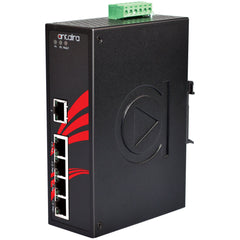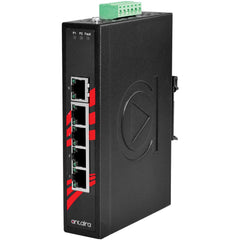Scroll to view all
switches
View Details


EISK5-100T | 5-port 10BASE-T / 100BASE-TX Skorpion switch, DIN-rail mount | Contemporary Controls
Brand: Contemporary Controls
SKU: EISK5-100T
View Details


EISK8-100T | 8-port 10BASE-T / 100BASE-TX Skorpion switch, DIN-rail mount | Contemporary Controls
Brand: Contemporary Controls
SKU: EISK8-100T
View Details


EISK16-100T | Skorpion 16-Port 10 / 100Mbps Switch | Contemporary Controls
Brand: Contemporary Controls
SKU: EISK16-100T
View Details


EISK8-GT | Gig Switch. 8-port 10BASE-T / 100BASE-TX / 1000BASE-T Skorpion switch, DIN-rail mount | Contemporary Controls
Brand: Contemporary Controls
SKU: EISK8-GT
View Details


EIBA5-100T / R | 5-Port 10 / 100Mbps DIN-rail Mount BAS Switch | Contemporary Controls
Brand: Contemporary Controls
SKU: EIBA5-100T/R
View Details


EISK5-GT | Gig Switch. 5-port 10BASE-T / 100BASE-TX / 1000BASE-T Skorpion switch, DIN-rail mount | Contemporary Controls
Brand: Contemporary Controls
SKU: EISK5-GT
View Details


EIBA5-100T | 5-port 10BASE-T / 100BASE-TX switching hub, panel mount | Contemporary Controls
Brand: Contemporary Controls
SKU: EIBA5-100T
View Details


EIS6-100T / FT | 4-Port 10 / 100Mbps 2-Port MM ST-fiber UL-864 EIS Switch | Contemporary Controls
Brand: Contemporary Controls
SKU: EIS6-100T/FT
View Details


EISK5-GT / H | Gig Switch 5-port 10BASE-T / 100BASE-TX / 1000BASE-T DIAGNOSTIC Skorpion switch, DIN-rail mount | Contemporary Controls
Brand: Contemporary Controls
SKU: EISK5-GT/H
View Details


EISW16-100T | 16-Port 10 / 100Mbps Wide-Temp Ethernet Switch -40 to +75C | Contemporary Controls
Brand: Contemporary Controls
SKU: EISW16-100T
View Details


EISK8-100T / FT | 6-port 100BASE-TX, 2-port 100BASE-FX (multimode) Skorpion switch w / ST connectors | Contemporary Controls (OBSOLETE)
Brand: Contemporary Controls
SKU: EISK8-100T/FT
View Details


EIS8-100T | 8-port 10BASE-T / 100BASE-TX switching hub UL864 | Contemporary Controls
Brand: Contemporary Controls
SKU: EIS8-100T
View Details


EISK5-100T / H | 5-port 10BASE-T / 100BASE-TX DIAGNOSTIC Skorpion switch, DIN-rail mount | Contemporary Controls
Brand: Contemporary Controls
SKU: EISK5-100T/H
View Details


EISK8P-GT | Gig Switch! Eight port 10BASE-T / 100BASE-TX / 1000BASE-T Skorpion switch with four PoE ports, DIN-rail mount | Contemporary Controls
Brand: Contemporary Controls
SKU: EISK8P-GT
View Details


EISK8-GT / H | Gig Switch 8-port 10BASE-T / 100BASE-TX / 1000BASE-T DIAGNOSTIC Skorpion switch, DIN-rail mount | Contemporary Controls
Brand: Contemporary Controls
SKU: EISK8-GT/H
View Details


EISK5-100T / FCS | 4-port 100BASE-TX, 1-port 100BASE-FX (single-mode) Skorpion switch w / SC connectors | Contemporary Controls
Brand: Contemporary Controls
SKU: EISK5-100T/FCS
View Details


EISK5-100T / FT | 4-Four-port 100BASE-TX, 1-port 100BASE-FX (multimode) Skorpion switch w / ST connectors | Contemporary Controls
Brand: Contemporary Controls
SKU: EISK5-100T/FT
View Details


EIS6-100T / FC | 4-port 100BASE-TX, 2-port 100BASE-FX (multimode) switching hub with SC connectors UL864 | Contemporary Controls
Brand: Contemporary Controls
SKU: EIS6-100T/FC
View Details


EISW8-100T | 8-Port 10 / 100Mbps Wide-Temp Ethernet Switch -40 to +75C | Contemporary Controls
Brand: Contemporary Controls
SKU: EISW8-100T
View Details


EISK8-100T / FCS | 6-port 100BASE-TX, 2-port 100BASE-FX (single-mode) Skorpion switch w / SC connectors | Contemporary Controls
Brand: Contemporary Controls
SKU: EISK8-100T/FCS
View Details


EISK8-100T / FC | 6-port 100BASE-TX, 2-port 100BASE-FX (multimode) Skorpion switch w / SC connectors | Contemporary Controls (OBSOLETE)
Brand: Contemporary Controls
SKU: EISK8-100T/FC
View Details


VW3A3601 | Ethercat 2 x RJ45 communication module | Square D by Schneider Electric
Brand: Square D
SKU: VW3A3601
Committed to customer satisfaction
as experts in Switches
Recently Viewed
Popular Products
View all →![Neptronic EHS45-600-10 1 Phase 45 Amps Multi-Signal Control | [NFEHS45-600-10] | Blackhawk Supply](http://blackhawksupply.com/cdn/shop/files/Ehs_top50_5be614da-dadc-4f89-b4d5-7838916e139a_large.png?v=1762525180)
EHS45-600-10 | 1 Phase 45 Amps Multi-Signal Control | [NFEHS45-600-10] | Neptronic
Brand: Neptronic
SKU: EHS45-600-10
PWLX04S | Pressure | Wet | Nema 4 | LCD | 0-100PSID | Veris
Brand: Veris
SKU: PWLX04S
iO-TWIN | Universal Twinning Kit | iO HVAC Controls
Brand: iO HVAC Controls
SKU: iO-TWIN
SKD62U | Flowrite Electro-Hydraulic Actuator, 24Vac, Proportional, SR, 3/4" Stroke | Siemens
Brand: Siemens
SKU: SKD62U
B220+LF120 US | CCV | 0.75" | 2 Way | 14 Cv | w/ Spg Rtn | 120V | On/Off | Belimo
Brand: Belimo
SKU: B220+LF120 US
ZIP-BT-NFC | Bluetooth to NFC converter for temporary wireless operation | Belimo
Brand: Belimo
SKU: ZIP-BT-NFC
NMB24-SR | Damper Actuator | 90 in-lb | Non-Spg Rtn | 24V | Modulating | Belimo
Brand: Belimo
SKU: NMB24-SR
FSNF120 US | Fire & Smoke Actuator | 70 in-lb | Spg Rtn | 120V | On/Off | 1m Cable | Belimo
Brand: Belimo
SKU: FSNF120 US

